How do you load a flatbed trailer? Get your trailer loaded easily with load planning software
Discover the wide range of flatbed trailers. This comprehensive guide looks at the different types of flatbeds and their uses, as well as loading issues associated with them. Optimize your transport process with insights into flatbed trailers and use loading software to get your job done smoothly.
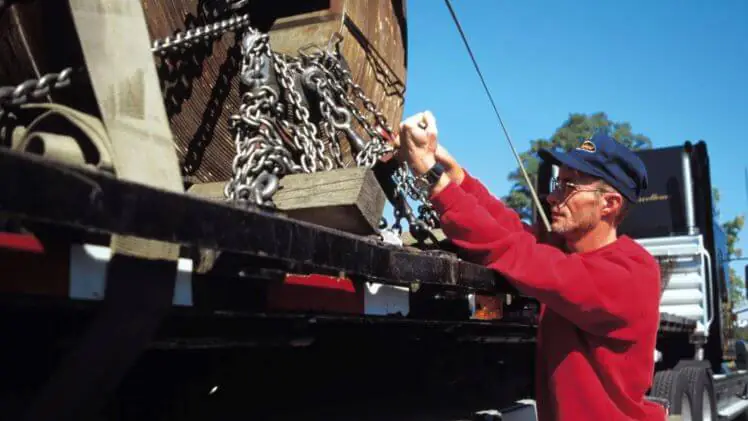
How do you load a flatbed trailer?
Given that multiple kinds of trailers can be used to ship products, we will discuss how to work with and handle shipments being transported on flatbed trailers. This is especially important as flatbed trailers are often used when transporting unstandardized goods from the heavy industry. Just like you would have special loading procedures when you load a pallet, there are also special loading procedures when loading a flatbed trailer.
This way, shipping goods and materials doesn’t lower the workload related to the sufficient way of loading trailers on the platform. We must plan the flatbeds’ size and weight balance, mainly when we ship items over long distances. This is a common occurrence when our supply chain is stretched. This is especially important to note when we ship special cargo such as construction materials or machinery to a facility on the other side of the country. All cargo items should be well placed on the board of flatbed trailers.
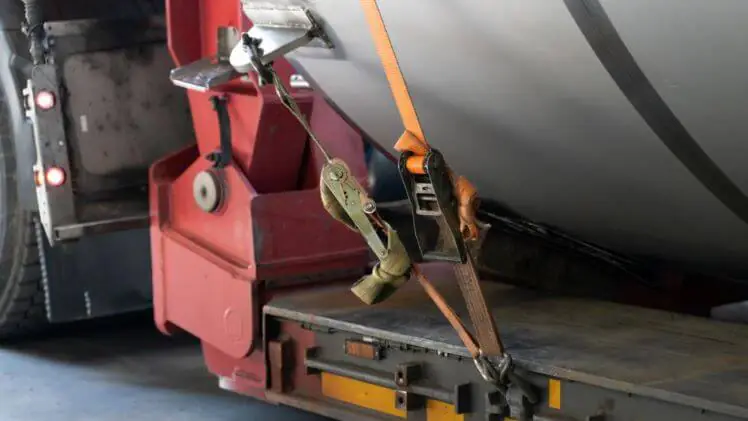
Companies are using load planning software for this purpose. You can provide maximum safety for transport and ensure your shipment will be delivered with no issues to its destination. In this article, we share challenges related to transportation on flatbed trailers and outline how to ship safely and effectively by using a shipment planning system. Keep your shipments safe upon arrival!
What is a flatbed trailer?
A flatbed trailer is a commercial trailer with a flat, open deck without sides or a roof. This design allows for easy loading and unloading of various types of cargo. As we said in the beginning, it is suitable mainly for transporting special cargo. This can range from unstandardized shapes of materials and goods to dangerous goods or even raw materials.
We often see a wide range of assorted transport on flatbed trailers dedicated to construction sites. Sometimes, loading goods is easy, but it can also cause the cargo to collapse, fall, or break.
Where are flat deck trailers used?
Flatbed or flat deck trailers are highly versatile and are used in a wide range of industries. Some industries use them more frequently than others. It all depends on the needs of the company. Some dedicated carriers handle only this kind of special cargo, requiring highly unstandardized shipping methods. For example, we often see wings from electric air turbine/windmill plants carried on flatbed trailers with exceptional transport escorts. Below are more specific examples:
Construction industry
Beyond heavy equipment, we often see building materials and machinery for the construction industry transported on flatbed trailers:
- Construction debris: Removing waste materials from construction sites.
- Prefabricated structures: Transporting pre-built components like modular homes or commercial units.
- Concrete: Hauling concrete on specialized, flatbed trailers equipped with mixers.
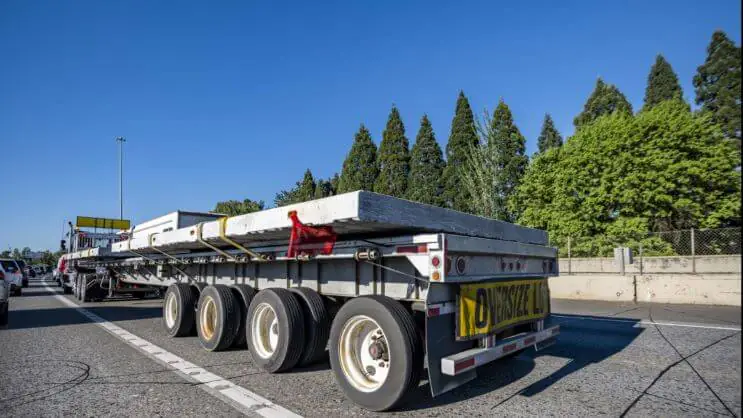
Manufacturing industry
In addition to the already mentioned raw materials, we often see cargo for the manufacturing industry, such as finished products and industrial equipment. Furthermore, flatbed trailers are used in manufacturing for:
- Steel and metal products: Transporting large steel beams, pipes, and other components.
- Machinery components: Hauling individual parts of large machines or industrial equipment.
- Automotive components: Transporting car parts, engines, and other automotive components.
Agriculture industry
Flatbed trailers are often used for several purposes in the agriculture industry. Although many people usually forget about the agricultural industry, the agriculture industry relies heavily on this type of cargo daily.
- Livestock transportation: Hauling livestock to and from farms, markets, and abattoirs.
- Grain and produce: Transporting bulk grains, fruits, vegetables, and other agricultural commodities.
- Agricultural equipment: Moving large farming machinery like tractors, combine harvesters, and planters.
Oversized Load Transportation
In general, flatbed trailers are essential for the transportation of oversized or, as previously mentioned, unstandardized goods. They are used in the energy industry and other sectors that still need them to support delivery in their supply chains.
- Wind turbine components: Hauling the massive blades, towers, and nacelles of wind turbines.
- Construction cranes: Transporting large construction cranes to and from job sites.
- Heavy machinery: Moving industrial machinery that exceeds the dimensions of standard trailers.
- Oil and gas equipment: Transporting large pipes, pumps, and other equipment in the oil and gas industry.
General Cargo
Last but not least, flatbed trailers are used for a wide range of general cargo. This may include the following:
- Shipping containers: A flatbed trailer can load a full container, up to 40ft., so you can transport empty or loaded shipping containers to and from ports.
- Heavy machinery: Moving various types of heavy machinery such as excavators, bulldozers, and forklifts.
- Military equipment: Transporting tanks, armored vehicles, and other military equipment.
- Industrial equipment: Hauling industrial equipment like generators, boilers, and compressors.
- Construction materials: Transporting various construction materials, including lumber, drywall, and roofing materials.
What are the different types of flatbed trailers?
Flatbed trailers come in various sizes and configurations to accommodate different cargo needs. You don’t always have to buy them. It is enough to hire a carrier or rent them for a dedicated shipment. Here are some common types of flatbeds:
- Utility Trailer: Smaller flatbed trailers are often used for personal or light commercial use.
- 12 ft Utility Trailer: A popular size for hauling smaller items like motorcycles, lawnmowers, or small appliances.
- 16-foot Flatbed Trailer: This slightly larger option is suitable for transporting furniture, small equipment, or building materials.
Flatbed Trailers: Larger trailers used for commercial transportation:
- 20 ft Flatbed Trailer: A standard size for hauling various cargo, including machinery and vehicles.
- 30 ft Gooseneck Trailer: A trailer with a gooseneck hitch, providing better weight distribution and stability for heavy shipments.
- 40 ft Flatbed Trailer: A large trailer for transporting oversized shipments or bulk materials.
- 48 ft Flatbed Trailer: An even larger trailer often used for long-haul transportation of heavy equipment or industrial goods.
- 53 ft Flatbed Trailer: The largest standard flatbed trailer, commonly used in intermodal transportation.
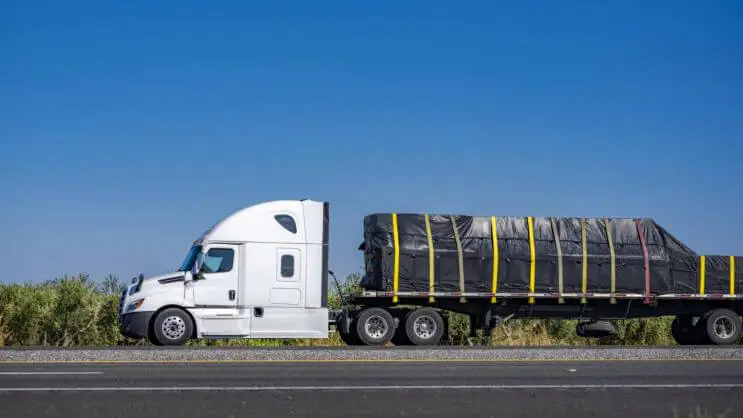
Specialized flatbed trailers: These are trailers dedicated to extensive and standardized shipments:
- Flatbed semi-trailer: This type of trailer can have 2 to 5 axles. Primarily, these are dedicated to cumbersome tasks with a total weight of up to 50 tons. They have excellent welded construction and are made of high-strength fine-grain steel. You can ship various types of cargo that can be loaded by air suspension. The cranked cargo bed area serves as a stop for wheeled or tracked vehicles. This means you can even transport other trucks on it if needed.
- Double Drop Trailer: A flatbed trailer with two drop-down axles, allowing for lower loading heights and allows for more accessible transportation of heavy or oversized equipment.
- Step Deck Trailer: A trailer with a raised deck at the front and a lower deck at the rear, providing a gradual slope for loading and unloading heavy equipment.
- Lowboy Trailer: A very low deck height trailer designed for transporting extremely heavy or oversized loads that require minimal clearance.
What are the challenges of loading a flatbed trailer?
Loading flatbed trailers can present several challenges, including:
Weight Distribution: We should pay attention to avoid uneven weight distribution. In every case, ensuring proper weight distribution is crucial to prevent overloading and maintain stability. Another vital aspect is overloading. Exceeding the trailer’s weight capacity can lead to structural damage, fines, and safety hazards.
Securing Cargo: During loading, we need to consider the risk of shifting or falling cargo. Cargo must be securely fastened to prevent shifting or falling off during transit. We must ensure proper tie-down techniques to hold the cargo tight during transport. Using appropriate tie-down methods and equipment is essential for securing cargo effectively.
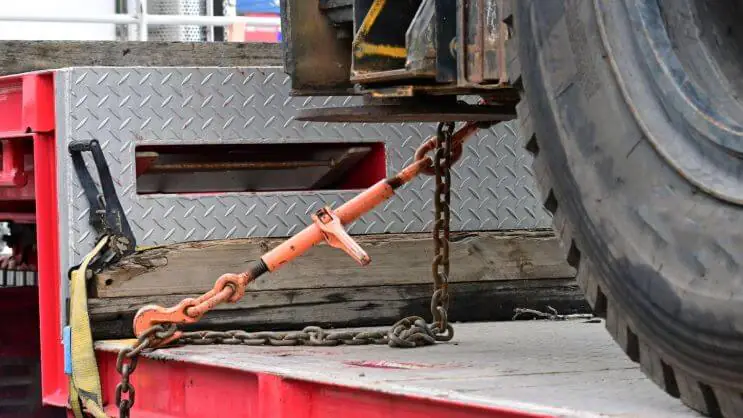
Oversized Shipments: We must consider height restrictions whenever we load cargo on a flatbed trailer. Let’s not forget that oversized shipments may encounter height restrictions on bridges, tunnels, and other structures. This also relates to permit requirements as transporting oversized shipments often requires special permits and escorts. Additionally, driver comfort should be considered, as maneuverability with oversized shipments can be difficult, especially in tight spaces.
Weather Conditions: We need to consider adverse weather conditions before transport. Rain, snow, or strong winds can make loading and unloading difficult and increase the risk of accidents. Moreover, this is also related to visibility. Reduced visibility due to inclement weather can impair the driver’s ability to operate the trailer safely. Not to mention that adverse weather conditions can affect the stability and ability to control the vehicle when operating in inclement weather.
Ramp Loading: We also should consider the process of loading and unloading the cargo. Ramp stability is essential, but we must also check if our loading partner has the same loading and unloading conditions. Ramps for loading and unloading must be stable and properly secured to prevent accidents. It’s also worth checking the ramp angle, as the angle can affect the ease of loading and unloading, especially for heavy or bulky items.
Equipment and Personnel: This subject always comes last to mind, but trained personnel are just as important as proper equipment. First, trained personnel are required to operate heavy equipment safely and efficiently. Second, having the necessary equipment, such as winches, forklifts, and cranes, is essential for loading and unloading certain types of cargo.
Loading software for Flatbed Trailers: How do you use it?
Loading software for flatbed trailers is a valuable tool that can help optimize cargo capacity. This can provide many benefits, like improved efficiency and minimized risks of losing cargo on the way. The main function of this kind of solution is to provide visual representations of the trailer and cargo. This should allow users to simulate loading processes and identify potential issues before actual loading begins.
Here is how to use it in a few steps:
Input the trailer’s specifications: Enter your flatbed trailer’s dimensions, weight capacity, and any specific features.
Add cargo items: Input each cargo item’s dimensions, weight, and location, or complete a bulk import of items using Excel.
Simulate loading: Arrange the cargo items on the virtual trailer. At that point, you can consider factors like weight distribution, stability, and compliance with regulations.
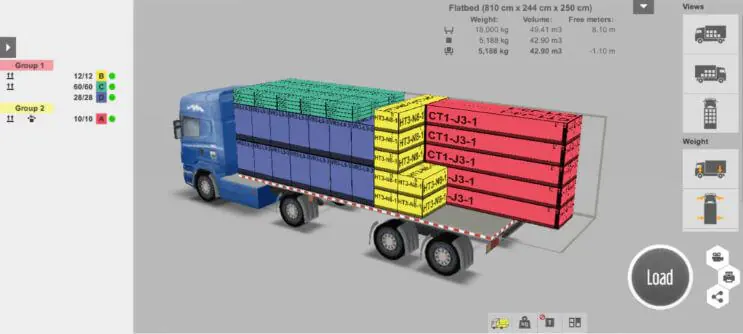
Analyze results: The software will calculate weight distribution and stability. This will help you comply with regulations. It may also provide visual cues to highlight potential issues.
Make adjustments: If necessary, adjust the cargo placement or consider alternative loading options to optimize the shipment.
Generate reports: Once everything is virtually loaded into the trailer, the software can generate reports summarizing the loading configuration. This can provide insights into weight distribution and compliance with regulations.
Summary
Flatbed trailers come in various sizes and configurations to meet different needs. They are undoubtedly helpful in transporting multiple types of goods. You can use anything from small utility trailers to large, specialized ones. Please keep in mind that loading flatbed trailers requires careful planning and consideration of factors like weight distribution. Your team should consider securing cargo and adhering to shipping compliance regulations. There are many things to take into consideration.
To support your transport business, you can utilize loading software. Using loading software to optimize cargo placement, you can see how efficiency is improved. You can prevent costly accidents and keep your operations running smoothly by giving people clear instructions upfront. See more about our software and try our load planning platform for free today!




